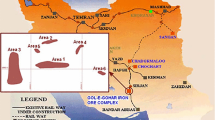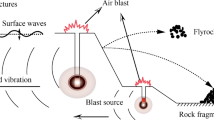Abstract
Drilling rate index (DRI) is an important index for evaluating the drillability of rock in mining, tunneling, and underground excavation. Various studies have been implemented to predict DRI based on the relationship between DRI and its influence factors. Meanwhile, many uncertainties are associated with the evaluation of DRI because of the complexity and nonlinearity of rock mechanical and physical properties. But the uncertainty has not been considered in previous studies. In this study, a novel method was proposed to evaluate DRI considering the uncertainty through combining the least square support vector machine (LSSVM) and Monte Carlo simulation (MCS). The LSSVM was adopted to map the relationship between DRI and rock strength index. Latin hypercube sampling (LHS) was used to produce the sample sets based on the uncertainty distribution of rock strength index. MCS was utilized to simulate the uncertainty of DRI. The proposed method was verified by three testing examples with the uncertainties. Interaction effects of DRI’s influence factors were analyzed and discussed. The results show the proposed method can evaluate the DRI reasonably. Compared with the determinate method, the proposed method is more rational and scientific and conforms to the rock engineering practice. Interaction effects should be considered while predicting or evaluating the DRI. LSSVM can not only present well the nonlinear relationship between DRI and its influence factors, but also deal with the interaction effects of the DRI’s influence factors. The proposed method provides a scientific tool to predict and evaluate the DRI and its uncertainty.








Similar content being viewed by others
References
Armaghani DJ, Mohamad ET, Momeni E, Narayanasamy MS (2014) An adaptive neuro-fuzzy inference system for predicting unconfined compressive strength and Young’s modulus: a study on main range granite. Bull Eng Geol Environ 74:1–19
Asadi M, Bagheripour MH, Eftekhari M (2013) Development of optimal fuzzy models for predicting the strength of intact rocks. Comput Geosci 54:107–112
Atici U (2011) Prediction of the strength of mineral admixture concrete using multivariable regression analysis and an artificial neural network. Expert Syst Appl 38:9609–9618
Barton N (2000) TBM tunnelling in jointed and faulted rock. Balkema, Rotterdam
Bruland A (1998) Drillability test methods. NTNU, Trondheim
Dahl F, Grøv E, Breivik E (2007) Development of a new direct test method for estimating cutter life based on the Sievers’ J miniature drill test. Tunn Undergr Space Technol 22(1):106–116
Dahl F, Bruland A, Grov E, Nilsen B (2010) Trademarking the NTNU/SINTEF drillability test indices. Tunnels Tunn Int 44–46
Dahl F, Bruland A, Jakobsen PD, Nilsen B, Grøv E (2012) Classifications of properties influencing the drillability of rocks based on the NTNU/SINTEF test method. Tunn Undergr Space Technol 28:150–158
Ekincioglu G, Altindag R, Sengun N, Demirdag S, Guney A (2013) Investigation of the relationships between drilling rate index (DRI), physico-mechanical properties and specific cutting energy for some carbonates rocks. Rock mechanics for resources, energy & environment, ISRM International Symposium - EUROCK 2013, 23–26 October, Wroclaw, Poland
Hadi F, Habibollah B (2017) Applying improved artificial neural network models to evaluate drilling rate index. Tunn Undergr Space Technol 70:114–124
Hoek E (1998) Reliability of Hoek-Brown estimates of rock mass properties and their impact on design. Int J Roc Mech Min Sci 35:63–68
Ji J, Zhang C, Gui Y et al (2017) New observations on the application of LS-SVM in slope system reliability analysis. J Comput Civ Eng 31(2):06016002
Khandelwal M, Armaghani DJ (2016) Prediction of drillability of rocks with strength properties using a hybrid GA-ANN technique. Geotech Geol Eng 34(2):605–620
Li HZ, Low BK (2010) Reliability analysis of circular tunnel under hydrostatic stress field. Comput Geotech 37:50–58
Li G, Yang M, Meng Y, Liu H, Han L, Zhou F, Zhang H (2016) The assessment of correlation between rock drillability and mechanical properties in the laboratory and in the field under different pressure conditions. J Nat Gas Sci Eng 30:405–413
Luckman PG, Der Kiureghian A, Sitar N (1987) Use of stochastic stability analysis for Bayesian back calculation of pore pressures acting in a cut at failure. Proceedings of the 5th International Conference on Application of Statistics and Probability in Soil and Structure Engineering, University of British Columbia, Vancouver
Lv Q, Low BK (2011) Probabilistic analysis of underground rock excavations using response surface method and SORM. Comput Geotech 38:1008–1021
Mehmet C, Ali OY, Serdar Y (2017) Relationships between the drilling rate index and physicomechanical rock properties. Bull Eng Geol Environ 76:253–261
Mollon G, Daniel D, Abdul HS (2011) Probabilistic analysis of pressurized tunnels against face stability using collocation-based stochastic response surface method. Probab Eng Mech 137(4):385–397
Okan S (2016) Performance evaluation of button bits in coal measure rocks by using multiple regression analyses. Rock Mech Rock Eng 49:541–553
Olgay Y, Eren S (2013) Assessment of relationships between drilling rate index and mechanical properties of rocks. Tunn Undergr Space Technol 33:46–53
Olgay Y, Sair K (2011) The drillability assessment of rocks using the different brittleness values. Tunn Undergr Space Technol 26:406–414
Oreste P (2005) A probabilistic design approach for tunnel supports. Comput Geotech 32:520–534
Rezaei M, Majdi A, Monjezi M (2014) An intelligent approach to predict unconfined compressive strength of rock surrounding access tunnels in longwall coal mining. Neural Comput Applic 24:233–241
Selmer-Olsen R, Lien R (1960) Bergartens borbarhet og sprengbarhet. Teknisk Ukeblad nr 34: Oslo pp 3–11
Sievers H (1950) Die Bestimmung des Bohrwiderstandes von Gesteinen. Gluckauf 86(37/38):776–784
Suykens JAK, Vandewalle J (1999) Squares support vector machine classifiers. Neural Process Lett 93:293–300
Von Matern N, Hjelmer A (1943) Forsok med pagrus (Tests with chippings), Medelande nr 65, Statens vaginstitut, Stockholm, 65 pp (English summary, pp 56–60)
Yasar S, Capik M, Yılmaz AO (2015) Cuttability assessment using the drilling rate index (DRI). Bull Eng Geol Environ 74(4):1349–1361
Ye KQ (1998) Orthogonal column Latin hypercubes and their application in computer experiments. J Am Stat Assoc 93(444):1430–1439
Yesiloglu-Gultekin N, Gokceoglu C, Sezer E (2013) Prediction of uniaxial compressive strength of granitic rocks by various nonlinear tools and comparison of their performances. Int J Rock Mech Min Sci 62:113–122
Yilmaz I, Yuksek G (2009) Prediction of the strength and elasticity modulus of gypsum using multiple regression, ANN, and ANFIS models. Int J Rock Mech Min Sci 46:803–810
Zare S, Bruland A (2013) Applications of NTNU/SINTEF drillability indices in hard rock tunneling. Rock Mech Rock Eng 46:179–187
Zhao H (2008) Slope reliability analysis using a support vector machine. Comput Geotech 35(3):459–467
Acknowledgements
The authors gratefully acknowledge financial support from the Program for Innovative Research Team (in Science and Technology) in University of Henan Province (no. 15IRTSTHN029).
Author information
Authors and Affiliations
Corresponding author
Rights and permissions
About this article
Cite this article
Ru, Z., Zhao, H. & Zhu, C. Probabilistic evaluation of drilling rate index based on a least square support vector machine and Monte Carlo simulation. Bull Eng Geol Environ 78, 3111–3118 (2019). https://doi.org/10.1007/s10064-018-1327-1
Received:
Accepted:
Published:
Issue Date:
DOI: https://doi.org/10.1007/s10064-018-1327-1




